Last Updated: 4 months ago
The cat had kittens outside, and you’re not sure what to do. This is the right place for you.
Oftentimes, a cat will have kittens outside, even if the cat spends a lot of time in the home.
Indoor and outdoor cats still sometimes have their kittens outside.
If your cat had kittens outside, this post can help you understand why it happened and how to help her.
Why Do Cats Hide Their Kittens?
There are several reasons why cats hide their kittens.
Before we get into that, though, there’s another important piece of information to address.
In the grand scheme of things, cats aren’t all that domesticated.
While humans have had both cats and dogs for centuries, cats are relatively new arrivals when you consider the length of time animals have been domesticated on this planet.
#1 Instinct
Cats have even more deeply ingrained instinctive behaviors than dogs.
Even the most friendly cats tend to be secretive in some ways.
- They enjoy small, cozy spaces well away from noise and irritations.
- They may hide or bury their food.
- They can be fiercely territorial.
Those gifts of dead animals that they bring us are another instinctive activity.
Even kneading when they are enjoying being scratched is an instinctive response.
Another instinctive behavior cats have is hiding their babies, even when they know and trust their families.
#2 Safety
Feral cats, or outdoor cats, hide their kittens to protect them from predators.
Like puppies, kittens are born blind and deaf, relying solely on their mother to keep them safe.
An outdoor cat will pick a spot that is difficult to find and/or get to in order to minimize any danger to her kittens from predators.
Coyotes, hawks, eagles, and even domesticated dogs all present a real danger to her kittens, so a safe, secluded spot is key.
Remember that instinct we discussed earlier? Instinctive drive plays a key role in one other predator of kittens: tom cats. Much like male lions in a pride, tom cats will often kill any kittens in their territory.
Doing so means that the mother cat will go back into heat sooner, giving him a better chance of mating with her and passing down his genetic code than that of a competitor male in the area.
#3 Secretiveness
Safety and secretiveness go hand in hand. If a cat has kittens, she’ll want a spot that is well away from lots of movement, even in the home.
Too much foot traffic in a room or too much interaction with her kittens too soon are both causes for her to move her kittens.
In addition, if a room is too noisy or too bright, she may decide to move her kittens to a more secluded location.
Oftentimes, an indoor mother cat will move her kittens to an area like a closet, under a bed, a dresser drawer, behind a sofa, or even a kitchen cabinet.
Once there, she may also decide that the area has become her territory and defend it aggressively, even from her owners.
Remember that instinct plays a huge part in this, so don’t yell or otherwise show aggressive behavior towards the cat.
How to Prevent Hiding if Your Cat Had Kittens
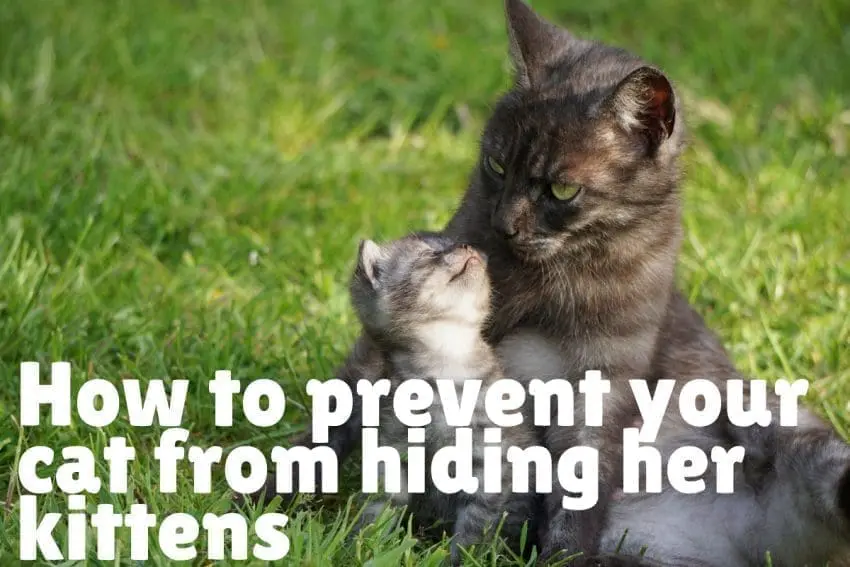
The most important thing to remember is that mother cats don’t like a lot of activity around their cats.
The best way to ensure that she won’t move her kittens to an undesirable location within the home is to give her a safe place to birth at the start.
A low box with a soft blanket in the bottom tucked into the corner of a quiet room can be a great place for your cat to keep her kittens.
Also remember that although you want well-socialized cats, too much interaction with kittens too soon can lead to the mother cat moving her kittens.
Give her her space. Stay out of the room except for cleanup, and keep children and other animals out of the area.
Explain to children and any visitors that they can’t see the kittens until they are older because you want to keep the mother cat comfortable and feeling safe.
Cat Had Kittens: Where Does She Hide Them?
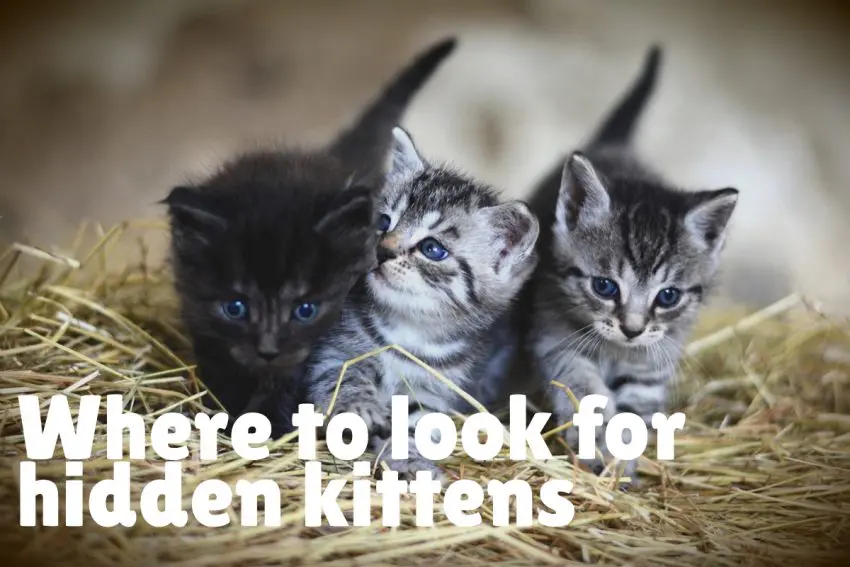
As I previously mentioned, if a cat had kittens, she would most likely have picked a spot that was quiet and out of the way.
Depending on the area, that could be any number of locations.
Cats will look for places that are quiet, low on traffic from humans or animals, and difficult for other animals besides the mother cat to reach.
Examples of locations where mother cats hide their kittens are:
- Under porches
- Under homes, if the cat has access to the crawl space
- In barns, usually, the loft or a difficult-to-reach cubby area
- Abandoned structures
- Any area that has a cubby-type depression or cave-like opening that offers a small, easily defended opening with plenty of room for mother and kittens
Why Do Cats Occasionally Pick Unsafe Locations?
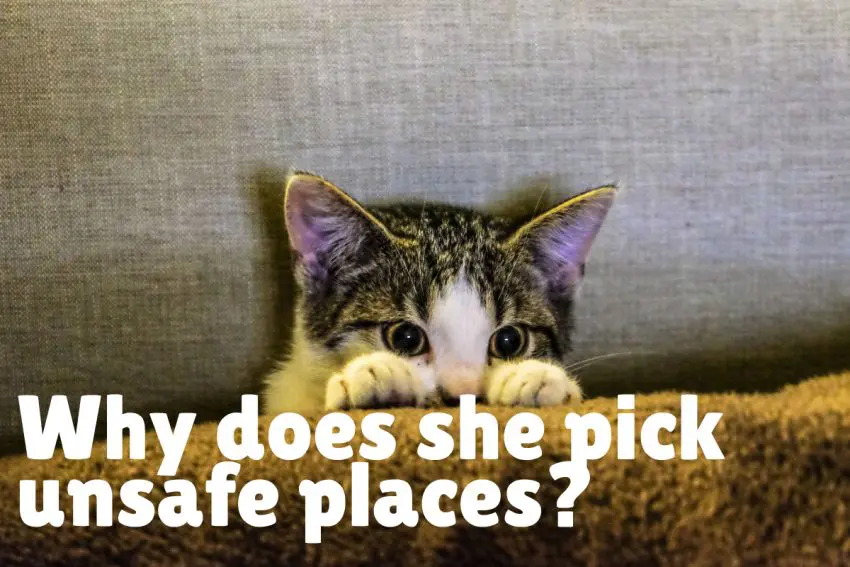
The simple answer to that is that the cat doesn’t know the location is unsafe.
For example, a house cat may move her kittens to an area like a basement that isn’t used often.
That basement could have lots of nooks, crannies, and items in it that present a danger to her kittens.
However, in her mind, it is safe because it’s quiet and away from lots of noise and commotion.
If an outdoor cat had kittens, she might pick a location that seems safe to her, but that really isn’t.
Moving her kittens under an old car in a barn or outdoor garage, for example, might look safe to her; however, she has no way of knowing that the car was scheduled for towing the following day.
Other examples are areas such as warehouses.
In general, any area that may seem initially quiet but has sporadic but intense bursts of activity is unsafe.
The mother cat will not understand this, however.
Why Do Cats Sometimes Move Only One Kitten?
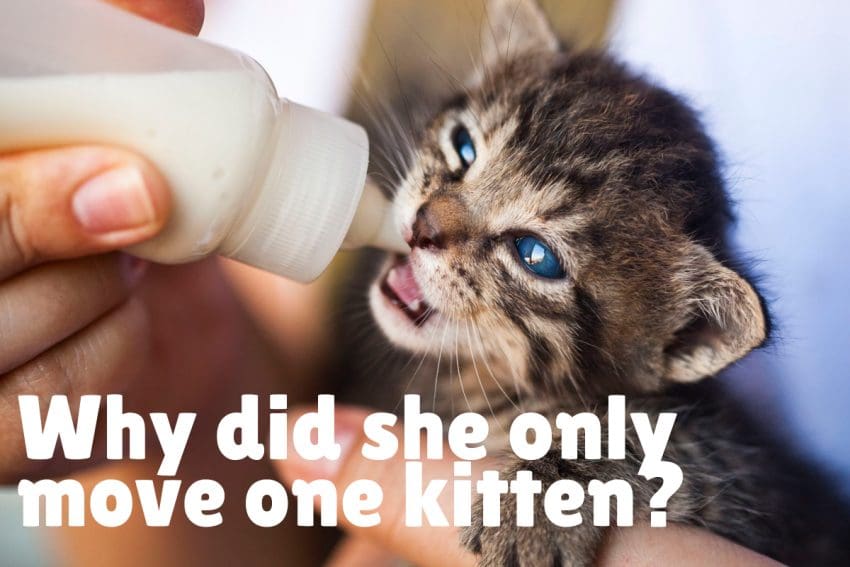
If you see that a cat has kittens outside, moving one kitten to another location or simply away from her other kittens, you may be seeing an instinctive drive to cull a sick kitten.
It’s a brutal fact of the animal kingdom that only the strong survive. Mother cats can sense if their kittens are unhealthy.
If the kitten is weak, is unable or unwilling to latch on for feeding, or too small, a mother cat will often abandon the kitten in order to save her energy for her healthier babies.
Oftentimes, people will see a cat moving one of her kittens and assume that the rest will be close behind.
Later, they discover that the kitten wasn’t the first one to be taken to a new location but rather had been culled.
People will often go to the new location, sometimes only several feet away, to check on the mother and her kittens, only to discover that the kitten has been abandoned.
If you see a mother moving a kitten, keep an eye out for the rest of the kittens to follow.
If you don’t see the mother or more kittens relatively quickly, retrieve the kitten if possible and take it to your local shelter immediately.
They have the resources to rehabilitate the kitten and get it adopted. If you want to adopt the kitten yourself, simply take it to your local vet for proper care.
Cat Had Kittens Outside: How to Find Her Newborns
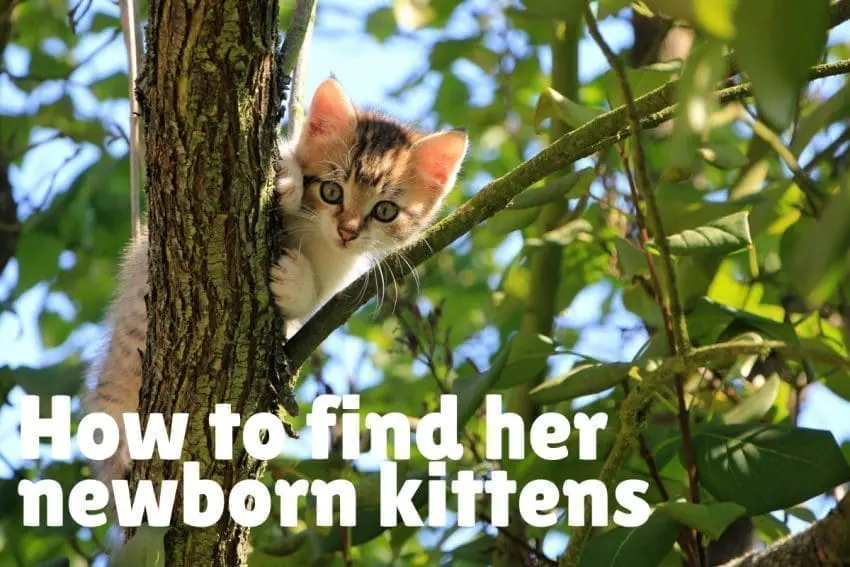
If your cat had kittens outside or if you know of a local feral cat who has had kittens, you’ll most likely be eager to find where they are.
Unfortunately, cats are very, very good at hiding their kitties, so you have to rely on three basic methods, all relying on the mother.
#1 Watch
As is most often the case with feral cats, you’ll need to keep a sharp eye on the mother.
Chances are, she has no trust in humans, and she will never willingly lead you to her kitten. Instead, watch her.
Take note of the areas that she frequents most. Of those areas, begin your search with the one that seems most secluded and quiet.
As stated earlier, the most likely areas to find kittens will be in structures like sheds or under porches, in crawl spaces, or in barns.
Just note the quietest spot and begin searching there.
#2 Follow
If your cat has kittens or the neighborhood cat isn’t feral but just homeless, you might be able to simply follow her back to her kittens.
Begin following her. If she stops to be petted, give her a little attention, and then ignore her until she decides to move on.
Repeat the process, and eventually (hopefully) she’ll lead you to her kittens.
This only works for very friendly cats, so be sure you take stock of the cat’s attitude towards humans before attempting this.
#3 Feed
A mother cat will need all the food she can get to produce enough milk to feed her babies.
She will actively seek out food, so make your home a grocery store for her.
Set out the tastiest wet and dry food you can find every day. Don’t worry, she’ll find it.
Over time, she’ll begin to associate your home with being a primary food source, which will, in turn, prompt her to move the kittens to an area near your home so she can access the food more easily.
Don’t rush to find the kittens if you notice her bringing them to your property.
Rather, watch her in order to determine where the kittens are. This is especially true if she’s feral.
You’ll want to have a pretty good idea of where the kittens are because if you disturb her new safe space, she’ll simply move them all over again.
Cat Had Kittens Outside? Take Your Time, and You’ll Find Them
If a cat had kittens outside, it’s important to find them right away.
No amount of preparation on the mother’s part can fully protect her or her kittens from predators, parasites, or the elements.
If she is your cat, you’ll want to be able to watch her and the kittens.
If she’s feral, she and her kittens will need to be properly cared for as soon as possible to ensure the highest possibility of their survival.
With the knowledge you’ve gained here, you should be able to find the mom and kittens sooner rather than later, which leads to better survival odds.
Want your kittens to come out of hiding? Watch this video:
Faqs
How to find kittens outside
There are many ways to find kittens outside, from letting your leashed dog sniff them out to leaving out food and waiting for them to show up. However, I’ve found that the easiest approach is to just covertly follow the mama cat. Unleash your inner PI and tail her to their location. Make sure she doesn’t see you, though. Binoculars come in really handy here.
Why do cats hide their kittens?
Cats hide their kittens for two obvious reasons: safety and security. Outside, kittens face countless dangers, from predators to rough weather and even well-meaning humans.
Where do cats hide their kittens inside?
That answer depends entirely on how much your cat trusts you. If you’ve established a strong bond, you may find that your cat is perfectly comfortable “hiding” her kittens on a blanket in your bedroom. Less trustful kitties may hide them in a closet, under a bed, or any other secure place that’s out of the way.


